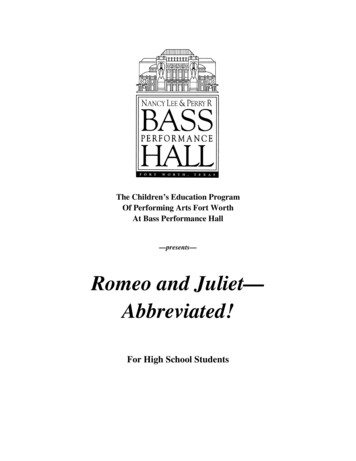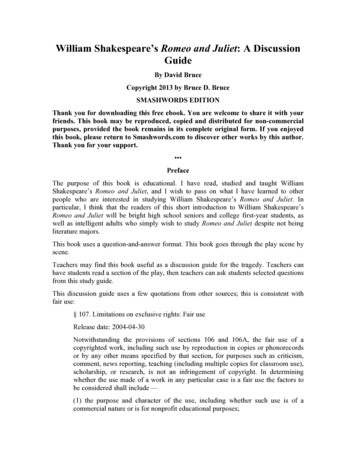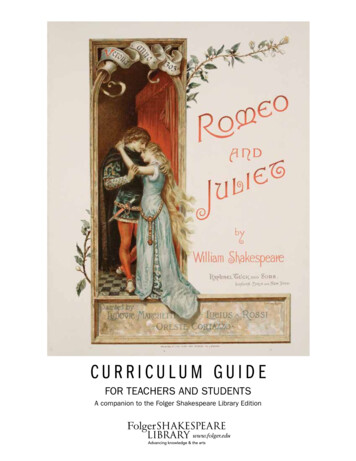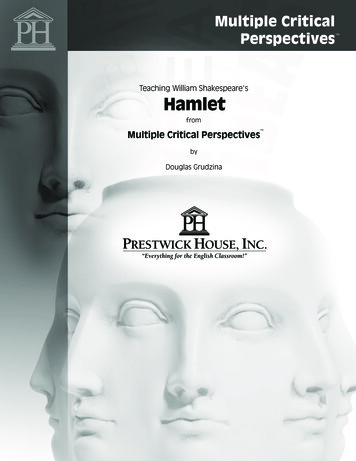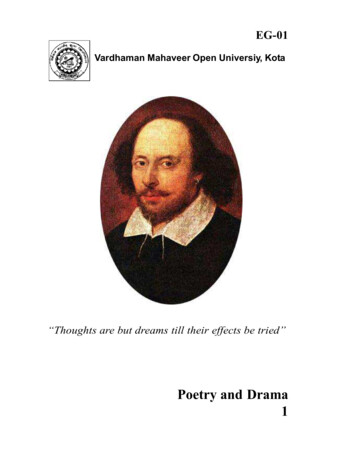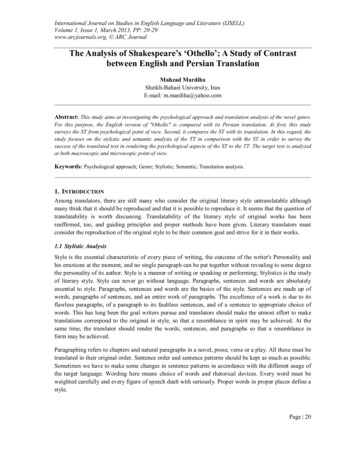
Transcription
International Journal on Studies in English Language and Literature (IJSELL)Volume 1, Issue 1, March 2013, PP: 20-29www.arcjournals.org, ARC JournalThe Analysis of Shakespeare’s ‘Othello’; A Study of Contrastbetween English and Persian TranslationMahzad MardihaSheikh-Bahaei University, IranE-mail: m.mardiha@yahoo.comAbstract: This study aims at investigating the psychological approach and translation analysis of the novel genre.For this purpose, the English version of "Othello" is compared with its Persian translation. At first, this studysurveys the ST from psychological point of view. Second, it compares the ST with its translation. In this regard, thestudy focuses on the stylistic and semantic analysis of the TT in comparison with the ST in order to survey thesuccess of the translated text in rendering the psychological aspects of the ST to the TT. The target text is analyzedat both macroscopic and microscopic point of view.Keywords: Psychological approach; Genre; Stylistic; Semantic; Translation analysis.1. INTRODUCTIONAmong translators, there are still many who consider the original literary style untranslatable althoughmany think that it should be reproduced and that it is possible to reproduce it. It seems that the question oftranslatability is worth discussing. Translatability of the literary style of original works has beenreaffirmed, too, and guiding principles and proper methods have been given. Literary translators mustconsider the reproduction of the original style to be their common goal and strive for it in their works.1.1 Stylistic AnalysisStyle is the essential characteristic of every piece of writing, the outcome of the writer's Personality andhis emotions at the moment, and no single paragraph can be put together without revealing to some degreethe personality of its author. Style is a manner of writing or speaking or performing; Stylistics is the studyof literary style. Style can never go without language. Paragraphs, sentences and words are absolutelyessential to style. Paragraphs, sentences and words are the basics of the style. Sentences are made up ofwords, paragraphs of sentences, and an entire work of paragraphs. The excellence of a work is due to itsflawless paragraphs, of a paragraph to its faultless sentences, and of a sentence to appropriate choice ofwords. This has long been the goal writers pursue and translators should make the utmost effort to maketranslations correspond to the original in style, so that a resemblance in spirit may be achieved. At thesame time, the translator should render the words, sentences, and paragraphs so that a resemblance inform may be achieved.Paragraphing refers to chapters and natural paragraphs in a novel, prose, verse or a play. All these must betranslated in their original order. Sentence order and sentence patterns should be kept as much as possible.Sometimes we have to make some changes in sentence patterns in accordance with the different usage ofthe target language. Wording here means choice of words and rhetorical devices. Every word must beweighted carefully and every figure of speech dealt with seriously. Proper words in proper places define astyle.Page 20
The Analysis of Shakespeare’s ‘Othello’; A Study of Contrast between English and Persian TranslationIf one wants to reproduce the original style satisfactorily, one must keep two points in mind beforeundertaking the translation. First, the translator must have a macroscopic point of view, namely, a view ofthe whole, and should always remember that what he is working at is a literary work written by somebodyelse and try his utmost to turn his translation into a work of art, which is in conformity with the thought,feelings and style of the original. Thus, the translation will be as moving and vivid as the original workand the reader may be aesthetically entertained as well.Second, he must have a microscopic point of view, namely, the linguistic point of view. In the process oftranslating, all the paragraphs, sentences, and words should be attentively studied so that the bestexpressions may be chosen to satisfy the needs of reproducing the thought, feeling, and style of theoriginal. From this point of view, style is formed by the coordination of paragraphs, sentences and words.Therefore, even if some individual sentences or words were not satisfactorily rendered, they would notaffect the style of the work as a whole.1.2 Semantic AnalysisSemantics is "the study of the linguistic meaning of words, phrases, and sentences" (Fromkin and Rodman1993). All parts of the language have some meaning (even if they are only "markers" like "wa" and "o" inJapanese). Words and morphemes have meanings. If we know the word "assassin", we know that it issomeone who is a human murderer, and is a killer of prominent people (Fromkin and Rodman). All wordscontain semantic properties such as that, sometimes more, sometimes less. A "tempter", for example, is aman who tempts (someone, usually a woman), while a "temptress" is a woman who tempts (someone,usually a man). Both words imply humans.Semantics and syntax closely interact in that something must generally be syntactically correct to besemantically correct (in turn, the words must also be morphologically correct). The semantics of thelanguage tell us when the syntax is incorrect because meaning is not present. However, one will often findsyntactically and semantically correct sentences that are still "false" in actuality but we have theknowledge in principle of how to discover the truth of a sentence, even if we do not have the direct meansto do so, because we know the language. If the language is unknown to the reader, then we do not haveany other way to determine its truth. Often, however, the truth of one sentence entails the truth of another(in much the same way that semantic redundancy rules imply properties of words). As we know how todetermine the truth of sentences, so do we know how to find the references of noun phrase objects(Fromkin and Rodman).2. MODEL FOR ANALYSIS2.1 The Psychoanalytical Approach· Most controversial and most abused,· Should be used with other approaches to enhance them and to give clues to unlocking themes andsymbolic meanings,· Excellent tool for reading between the lines,· This approach became popular in the 20th century after Sigmund Freud published his work on theinner workings of the human mind,· This approach focuses on analyzing characters’ behaviors and their motivations.2.2 Freud’s Theory· Sigmund Freud's Theory is quite complex and although his writings on psychosexualdevelopment set the groundwork for how our personalities developed, it was only one of the fiveparts to his overall theory of personality. He also believed that different driving forces developduring these stages which play an important role in how we interact with the world.International Journal on Studies in English Language and Literature (IJSELL)Page 21
The Analysis of Shakespeare’s ‘Othello’; A Study of Contrast between English and Persian Translation· Emphasizes the unconscious aspects of the human psyche,· The unconscious mind is dominant,· Human actions (mental processes) are controlled by the unconscious mind (i.e. like an icebergthe human is constructed with its greatest density below the level of consciousness),· Belief that most of our actions are motivated by psychological forces over which we have verylimited control,· All human behavior is motivated ultimately by sexuality (libido),· The psyche is organized into three zones: id, ego, and superego.2.2.1 IDAccording to Freud, we are born with our Id. The id is an important part of our personality because asnewborns, it allows us to get our basic needs met. Freud believed that the id is based on our pleasureprinciple. In other words, the id wants whatever feels good at the time, with no consideration for thereality of the situation. When a child is hungry, the id wants food, and therefore the child cries. When thechild is uncomfortable, in pain, too hot, too cold, or just wants attention, the id speaks up until his or herneeds are met. The id doesn't care about reality, about the needs of anyone else, only its ownsatisfaction. If you think about it, babies are not real considerate of their parents' wishes. They have nocare for time, whether their parents are sleeping, relaxing, eating dinner, or bathing. When the id wantssomething, nothing else is important.-Entirely unconscious; functions to fulfill the primordial life principle (pleasure principle);The source of all our aggressions and desires;It is lawless, asocial and amoral;Animalistic without reason or logic;Its function is to gratify our instincts for pleasure without regard for social conventions, legalethics or moral restraint;- Destructive (even self-destructive) to satisfy its impulses for pleasure;- Theologians call it the devil.2.2.2 EGOWithin the next three years, as the child interacts more and more with the world, the second part of thepersonality begins to develop. Freud called this part the Ego. The ego is based on the realityprinciple. The ego understands that other people have needs and desires and that sometimes beingimpulsive or selfish can hurt us in the long run. It’s the ego's job to meet the needs of the id, while takinginto consideration the reality of the situation.-Partially unconscious;Stands for reason;Rational governing agent of the psyche;Governed by the reality principle;Regulates the instinctual drives of the id so that they may be released in socially acceptable forms(nondestructive behavioral patterns);- Determines when, where and how id’s demands may be gratified in ways that are acceptable;- Balance between id and superego;- When not in balance, neurosis occurs.2.2.3 SUPEREGOBy the age of five, or the end of the phallic stage of development, the Superego develops. The Superego isthe moral part of us and develops due to the moral and ethical restraints placed on us by ourcaregivers. Many equate the superego with the conscience as it dictates our belief of right and wrong.- Largely unconscious – moral censoring agent,International Journal on Studies in English Language and Literature (IJSELL)Page 22
The Analysis of Shakespeare’s ‘Othello’; A Study of Contrast between English and Persian Translation- Repository of conscience and pride- dominated by the morality principle,- Serves to repress or inhibit the drives of the id,- Blocks impulses towards pleasure that society regards as unacceptable,- Advocate of impulse towards perfectionist,- An overactive superego creates an unconscious sense of guilt – hence the term guilt complex,- Development of superego attributed to parental influence.In figurative terms: ID would make us devils/animals; SUPEREGO would make us angels. The EGOkeeps us healthy by maintaining a balance between the two opposing forces.····The unconscious is not observable by direct examination, therefore the ID is revealed onlythrough deep hypnosis, during unintentional expressions(Freudian slips), or during sleepthrough the analysis of dreams.During dreams the superego is still functioning, therefore dreams are symbols ofunsatisfied/repressed desires of the ID.Since dreams are the expressions of the ID and the ID is the source for sexual needs and desires,dreams are, Freud believed best interpreted in terms of repressed sexuality.Psychoanalytical critics examine literature for (sexual) female and male images:- All concave images womb symbols (flowers, ponds, caves, hollows, cups, or rings).- All images whose length exceeds their diameter male or phallic symbols (towers, mountainpeaks, swords, knives, snakes or arrows).The most controversial facet of this approach is the tendency to interpret imagery in terms ofsexuality.· Another controversial issue is Freud’s theories concerning child psychology:Þ Found infancy and childhood a period of intense sexual experience.Þ Child passes through phases of erotic growth – each phase centered on erogenous zones (portionsof the body where physical pleasure is most intense): oral, anal, and genital.Þ If a child is frustrated in gratifying his/her needs, his/her personality may be warped.Þ Oedipus and Electra complex are associated with this phase. Oedipus complex is a boy’s rivalrywith his father for the attention and love of his mother. Electra complex is a girl’s rivalry with hermother for the attention and love of her father.This approach is valid in some situations but should not be overused; it is best used in conjunction withother approaches.In a healthy person, according to Freud, the ego is the strongest so that it can satisfy the needs of the id,not upset the superego, and still take into consideration the reality of every situation. Not an easy job byany means, but if the id gets too strong, impulses and self gratification take over the person's life. If thesuperego becomes too strong, the person would be driven by rigid morals, would be judgmental andunbending in his or her interactions with the world. You'll learn how the ego maintains control as youcontinue to read.2.3 Topographical ModelFreud believed that the majority of what we experience in our lives, the underlying emotions, beliefs,feelings, and impulses are not available to us at a conscious level. He believed that most of what drives usis buried in our unconscious. If you remember the Oedipus and Electra Complex, they were both pusheddown into the unconscious, out of our awareness due to the extreme anxiety they caused. While buriedthere, however, they continue to impact us dramatically according to Freud.International Journal on Studies in English Language and Literature (IJSELL)Page 23
The Analysis of Shakespeare’s ‘Othello’; A Study of Contrast between English and Persian TranslationThe role of the unconscious is only onepart of the model. Freud also believed thateverything we are aware of is stored in ourconscious. Our conscious makes up a verysmall part of who we are. In other words,at any given time, we are only aware of avery small part of what makes up ourpersonality; most of what we are is buriedand inaccessible.The final part is the preconscious orsubconscious. This is the part of us that wecan access if prompted, but is not in ouractive conscious. It is right below thesurface, but still buried somewhat unless wesearch for it. Information such as ourtelephone number, some childhoodmemories, or the name of your bestchildhood friend is stored in the preconscious.Because the unconscious is so large, and because we are only aware of the very small conscious at anygiven time, this theory has been likened to an iceberg, where the vast majority is buried beneath thewater's surface. The water, by the way, would represent everything that we are not aware of, are notexperienced, and that has not been integrated into our personalities, referred to as the unconscious.3. METHODOLOGYThis study adopts a text analysis approach in handling the data, following the English version of the play“Othello, the Moor of Venice” by William Shakespeare (1604), and it’s comparison with its translation“Othello, Maghrebi dar Veniz” by Abolghasemkhan Naserolmolk from the psychological approach.3.1 Data Analysis (Analysis of Basic Elements of Othello)3.1.1 Plot SummaryThe play opens in Venice, Italy, at night. In the opening scene, Iago complains that Othello, hisCommander, has passed him over to promote handsome Cassio to be his Lieutenant. He vows to getrevenge. Iago first asks his friend Roderigo to tell Desdemona's father Brabantio that his daughter has leftto marry Othello, a marriage Brabantio opposes because Othello is a Moor (an African). Brabantioconfronts Othello, and they take their argument to the Duke, who has summoned Othello to ask him to sailto Cyprus to stop a Turkish invasion. Convinced by Othello and Desdemona that they love each otherdeeply despite their differences, the Duke gives Desdemona permission to travel with Othello. By the timethey reach Cyprus the foreign threat is gone.Iago has Roderigo got Cassio drunk and draw him into a street fight. Iago has his revenge on Cassio whenOthello strips Cassio of his rank for misbehavior. Then Iago decides to make Othello believe his wife isunfaithful. He encourages Cassio to ask Desdemona to plead with Othello to be reinstated. Iago suggeststo Othello that Desdemona is Cassio's lover. Trusting Iago and mad with jealousy, Othello promotes Iagoand asks Iago to help him kill Cassio and Desdemona.International Journal on Studies in English Language and Literature (IJSELL)Page 24
The Analysis of Shakespeare’s ‘Othello’; A Study of Contrast between English and Persian TranslationIago plants Desdemona's handkerchief in Cassio's room. Cassio gives it to his mistress, Bianca. Othellobelieves Bianca's possession of the handkerchief is proof that Desdemona and Cassio are lovers. Heverbally abuses his wife in front of others, who are shocked at the change in the noble and powerful man.Iago has manipulated Roderigo into trying to kill Cassio. The attempt goes wrong, and Cassio woundsRoderigo; Iago stabs Cassio in the leg. Othello hears Cassio cry out and thinks Iago has killed him. Hereturns home, ready to kill Desdemona. Meanwhile, Iago "finds" the wounded Cassio and accuses Biancaof causing Cassio's injury. Iago quietly kills Roderigo and sends Emilia (Iago's wife) to Desdemona withnews of what has happened.Othello reaches the sleeping Desdemona first. Othello kisses her, wakes her, and accuses her again. Overher protests that she loves him and is innocent, he smothers her. Emilia enters and Desdemona revives fora moment, declaring she is guiltless but saying, as she dies, that Othello is innocent of her death. Iago andothers enter, and Emilia defends Desdemona's innocence, recognizing that Iago is behind the tragedy.Othello sees the truth and tries to kill Iago. Iago kills Emilia and flees; Othello condemns himself andcommits suicide. Iago is seized and taken away.3.1.2Theme, Motifs and Symbols in OthelloA theme in a literary work is a recurring, unifying subject or idea, a motif that allows us to understandmore deeply the characters and their world. In Othello, the major themes reflect the values and themotivations of the characters.Jealousy: Traditionally, Othello was read as a cautionary tale about the destructive nature of the greeneyed monster, jealousy. Certainly, the play is filled with examples of jealousy, each contributing to theclaustrophobic atmosphere of plot and counterplot, all orchestrated by Iago. Iago himself attributes hishatred of Othello to numerous sorts of jealousy: he is jealous of Michael Cassio because he believes thatCassio has been promoted unjustly over him and because he believes that Cassio might have had an affairwith his wife. Iago is jealous of Othello because he believes that Othello might have had sex with his wifeand because he says that he loves Desdemona himself. It is almost as if Iago examines the various kinds ofjealousy he finds in himself in order to exploit those jealousies in others. For example, he firstmanipulates Roderigo. Roderigo, in love with Desdemona, is very jealous of Othello and by extension ofCassio. His jealousy makes him an easy dupe for Iago's plotting. Likewise, Bianca is jealous of anywoman in whom Cassio might be interested, and thus she also can be manipulated by Iago. Of course, themost destructive jealous rage that Iago incites is that within Othello. Iago uses his own fear of cuckoldryas the basis for his plot against Othello. By projecting his own feelings (and a common cultural fear) ontoOthello, he is able to convince Othello that what he fears most, Desdemona's betrayal, is a reality. It isjealousy that weakens Othello's mind and reason, thus rendering him increasingly vulnerable to Iago'splots.Love: Love triumphs in Othello, but it’s a bitter victory. Desdemona never stops loving her husband, evenwhen he accuses her of cheating on him, slaps her in public, calls her a whore, and strangles her to death.With her last breath, Desdemona chooses to blame herself for her death rather than implicate Othello. Thestrength of her love is particularly impressive, as it proves impervious to the machinations of Iago, theplay’s villain. Iago does not believe in love; he reduces it in his mind to dirty desire. While his schemingdestroys the central couple’s marriage and lives, what he cannot destroy is their love. The role of love inthe play is further complicated by Othello’s debatable claim that he loved "not wisely, but too well." Inthis line, Othello reminds us that the passion of love outdoes the reason of logic.International Journal on Studies in English Language and Literature (IJSELL)Page 25
The Analysis of Shakespeare’s ‘Othello’; A Study of Contrast between English and Persian TranslationSexuality: Othello stands out among Shakespeare's works as the most troublingly sexual of all plays.Indeed, it is the issue of sex that causes the downfall of both Othello and Desdemona. In the openingscene, Iago and Roderigo awaken Brabantio to inform him of Desdemona's elopement. Their language isobscene and racist: "An old black ram / Is tupping your white ewe," Iago shouts, "Your daughter / and theMoor are making the beast with two backs."Further, Shakespeare calls attention to the nuptial nightbetween Othello and Desdemona by having it interrupted several times, first in Venice when Othello iscalled to the Senate and later in Cyprus when Cassio stabs Montano. This serves to produce extremesexual tension; in the scenes shared by Othello and Desdemona, their language is highly charged withinterrupted desire. For Othello, thoughts of sexual infidelity are also at the heart of his total disintegration.After murdering Desdemona, the thoughts of her supposed promiscuity continue to eat at Othello. "Iagoknows t hat she with Cassio hath the act of shame / A thousand times committed," Othello says in his owndefense. The fear of cuckoldry runs deep in many of Shakespeare's plays; yet in most plays it is a matterof joke and play. In Othello, however, Shakespeare demonstrates how such fear, when attached withdeeper issues of sexuality, can turn tragic.3.1.3SymbolsSymbols are objects, characters, figures, or colors used to represent abstract ideas or conceptsThe Handkerchief: The handkerchief symbolizes different things to different characters. Since thehandkerchief was the first gift Desdemona received from Othello, she keeps it about her constantly as asymbol of Othello’s love. Iago manipulates the handkerchief so that Othello comes to see it as a symbol ofDesdemona herself—her faith and chastity. By taking possession of it, he is able to convert it intoevidence of her infidelity. The symbol of the handkerchief is at the heart of the play's terrible irony. Givenis a gift of true, honest, faithful love by Othello to Desdemona, it ultimately becomes a sign of Othello'sjealousy, mistrust, and insecurity. One cannot trace this change in the symbol's significance withoutappreciating Iago's continual manipulation of Othello. Both the handkerchief and Desdemona remain pureand unchanged, however Iago is able to change Othello's perception of them. One of Shakespeare'srecurring themes is the power of perception--Othello is willing to commit the most horrible of crimesbased not upon facts, but upon his faulty interpretation of reality.The Song “Willow”: Willow Song is another good symbol in Othello. Though it's just a song, itsymbolizes Desdemona's similar doom to the Barbary maid who sang Willow, Willow, and was killedshortly after. Othello, at this point in the story, is plotting Desdemona's murder in her bed bystrangulation. Since the Willow song was a song about infidelity and betrayal, it was a parallel directly tothe case between Desdemona and Othello. The song’s lyrics suggest that both men and women areunfaithful to one another. To Desdemona, the song seems to represent a melancholy and resignedacceptance of her alienation from Othello’s affections, and singing it leads her to question Emilia aboutthe nature and practice of infidelity.Animals: Iago calls Othello a “Barbary horse,” an “old black ram,” and also tells Brabantio that hisdaughter and Othello are “making the beast with two backs” (I.i.117–118). In Act I, scene iii, Iago tellsRoderigo, “Ere I would say I would drown myself for the love of a guinea-hen, I would change myhumanity with a baboon” (I.iii.312–313). He then remarks that drowning is for “cats and blind puppies”(I.iii.330–331). Cassio laments that, when drunk, he is “by and by a fool, and presently a beast!”(II.iii.284–285). Othello tells Iago, “Exchange me for a goat / When I shall turn the business of my soul /To such exsufflicate and blowed surmises” (III.iii.184–186). He later says that “[a] horned man’s amonster and a beast” (IV.i.59). Even Emilia, in the final scene, says that she will “play the swan, / And dieInternational Journal on Studies in English Language and Literature (IJSELL)Page 26
The Analysis of Shakespeare’s ‘Othello’; A Study of Contrast between English and Persian Translationin music” (V.ii.254–255). Like the repeated references to plants, these references to animals convey asense that the laws of nature, rather than those of society, are the primary forces governing the charactersin this play. When animal references are used with regard to Othello, as they frequently are, they reflectthe racism both of characters in the play and of Shakespeare’s contemporary audience. “Barbary horse” isa vulgarity particularly appropriate in the mouth of Iago, but even without having seen Othello, theJacobean audience would have known from Iago’s metaphor that he meant to connote a savage Moor.3.1.4CharactersOthello: Othello is a general in the army of Venice. He is a Moor, a dark-skinned man born in Africa,and has risen through the ranks of the Venetian army through hard work and success in battle. He is arespected general, but less respected as a person, because of his dark skin and foreign roots. He is anhonest man, and believes that people are honest. This makes him naive in many ways. Othello is apassionate man, and deeply loves Desdemona, even when he kills her. Iago uses Othello's trust in him tomanipulate him, and Othello stops trusting in Desdemona, and begins to rely exclusively on Iago'sadvice. Desdemona was Othello's passion, and when she dies, he must die soon after, especially after helearns that she was innocent.Desdemona: Desdemona is loyal, faithful, and passionately loves Othello. She is shrewd and wise, but isvery subtle about it. She dies because she keeps blindingly faithful to Othello, and cannot understand whyhe believes her to be an adulterous. She asks Cassio to help her cheer up Othello, but Iago manipulatesfacts to make Othello even more jealous. She is blameless, and she dies tragically, so selfless as to denythat Othello has killed her in her dying breath.Iago: Iago is Othello's sword-bearer. He has been passed over for the position of Lieutenant, and thisdraws out his evil nature. He feels that he has been wronged and cannot accept the position that Othellogives him. Iago orchestrates Othello's downfall out of malice and revenge, and it is worse because Iagocoats his poisonous words in the appearance of truth. Othello has no reason to doubt Iago, and Iago isable to completely manipulate Othello and to control his actions. Othello kills Desdemona, but Iago isresponsible. Iago is only concerned about himself and his position, and will sacrifice anyone to savehimself and his interests. This is shown when he kills his own wife when it is discovered that he has beentreacherous.Emilia: Emilia is Desdemona's female servant. She is Iago's husband, and has a practical and shrewdsense about her that is more apparent than Desdemona's. Emilia urges Desdemona to confront Othello,and when she learns of Iago's treachery, she reveals him, even though it costs her life. She is a goodfriend and companion to Desdemona, but unfortunately she puts into motion the events that lead Othelloto believe that he has seen proof of Desdemona's unfaithfulness.Cassio: Cassio is Othello's choice for his new Lieutenant. Cassio travels from a different city, and hisreputation is known in far lands. He is an up and coming soldier, and a good friend to Othello. Cassioand Desdemona try to help Othello's jealousy together in friendship, but due to Iago's clouding ofOthello's perception, this leads him to think that they are having an affair.3.1.5StyleIrony: Harmon and Holman in A Handbook to Literature define irony as "a broad term referring to therecognition of a reality different from appearance." Othello is an essentially ironic play in thatShakespeare creates such a wide divide between what appears to be real to the characters in the play andInternational Journal on Studies in English Language and Literature (IJSELL)Page 27
The Analysis of Shakespeare’s ‘Othello’; A Study of Contrast between English and Persian Translationwhat appears to be real to the audience in the theater. He does this through several devices. In the firstplace, Shakespeare offers Iago some of the best language in the playwright's whole body of work.Consequently, Iago appears to the other characters as well spoken, appealing, and attractive. His languagemakes him someone they trust. This is evident from the number of times a character (particularly Othello)refers to Iago as "honest." Iago does not look like the villain he is. In this, Shakespeare deviates from thetraditions of the Middle Ages in which evil characters always exhibit some degree of the evil on thesurface. Indeed, in medieval romance, characters are as they appear: an ugly character is inevitably evil.Shakespeare plays with both audience and character horizon of expectation here. The first gap, then, isbetween what the characters and audience expect from such an attractive and well-spoken character andwhat
dreams are, Freud believed best interpreted in terms of repressed sexuality. Psychoanalytical critics examine literature for (sexual) female and male images:-All concave images womb symbols (flowers, ponds, caves, hollows, cups, or rings). - All images whose length exceeds their diameter male or phallic symbols (towers, mountain




